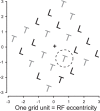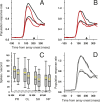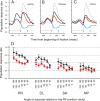Saccadic momentum and attentive control in V4 neurons during visual search
- PMID: 30357345
- PMCID: PMC6200271
- DOI: 10.1167/18.11.16
Saccadic momentum and attentive control in V4 neurons during visual search
Abstract
Saccadic momentum refers to the increased probability of making a saccade in a forward direction relative to the previous saccade. During visual search and free viewing conditions saccadic probability falls in a gradient from forward to backward directions. It has been considered to reflect an oculomotor bias for a continuing motor plan. Here we report that a saccadic momentum gradient is observed in nonhuman primate behavior and in the visual responses of cortical area V4 neurons during a conjunction style visual search task. This result suggests that saccadic momentum arises in part from a biased spatial distribution of visual responses to stimuli. The effect is independent of feature-based selective attention and overridden by directed spatial attention. The implications of saccadic momentum for search guidance are much broader and robust than the inhibition-of-return's presumed role in preventing refixation of recent locations.
Figures









Similar articles
-
Mechanisms of Saccadic Suppression in Primate Cortical Area V4.J Neurosci. 2016 Aug 31;36(35):9227-39. doi: 10.1523/JNEUROSCI.1015-16.2016. J Neurosci. 2016. PMID: 27581462 Free PMC article.
-
Global selection of saccadic target features by neurons in area v4.J Neurosci. 2014 May 7;34(19):6700-6. doi: 10.1523/JNEUROSCI.0867-13.2014. J Neurosci. 2014. PMID: 24806696 Free PMC article.
-
Activity in V4 reflects the direction, but not the latency, of saccades during visual search.J Neurophysiol. 2010 Oct;104(4):2187-93. doi: 10.1152/jn.00898.2009. Epub 2010 Jul 7. J Neurophysiol. 2010. PMID: 20610790 Free PMC article.
-
Top-down control of visual attention.Curr Opin Neurobiol. 2010 Apr;20(2):183-90. doi: 10.1016/j.conb.2010.02.003. Epub 2010 Mar 19. Curr Opin Neurobiol. 2010. PMID: 20303256 Free PMC article. Review.
-
Cortical mechanisms for trans-saccadic memory and integration of multiple object features.Philos Trans R Soc Lond B Biol Sci. 2011 Feb 27;366(1564):540-53. doi: 10.1098/rstb.2010.0184. Philos Trans R Soc Lond B Biol Sci. 2011. PMID: 21242142 Free PMC article. Review.
Cited by
-
Synchronization between frontal eye field and area V4 during free-gaze visual search.Zool Res. 2019 Sep 18;40(5):394-403. doi: 10.24272/j.issn.2095-8137.2019.055. Zool Res. 2019. PMID: 31393096 Free PMC article.
-
A large neuronal dataset for natural category-based free-gaze visual search in macaques.Sci Data. 2025 May 13;12(1):779. doi: 10.1038/s41597-025-05130-5. Sci Data. 2025. PMID: 40355416 Free PMC article.
-
A robotics-inspired scanpath model reveals the importance of uncertainty and semantic object cues for gaze guidance in dynamic scenes.J Vis. 2025 Feb 3;25(2):6. doi: 10.1167/jov.25.2.6. J Vis. 2025. PMID: 39928323 Free PMC article.
References
-
- Bichot N. P, Rossi A. F, Desimone R. Parallel and serial neural mechanisms for visual search in macaque area V4. Science. (2005, April 22);308:529–534. - PubMed
Publication types
MeSH terms
Grants and funding
LinkOut - more resources
Full Text Sources

